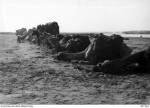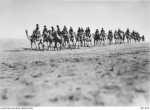BIRBECK, Harry
Harry Birbeck was one of eight children of William Henry Birbeck and Margaret Jane Sutton of Laura, South Australia. Three of their children died in childhood, Frederick born 1882 at 9 months, Horace born 1880 at 3 years and Emily born 1888 at 2 months. Harry was their third child, born 1 July, 1881. A baker by trade, he was living at 535 Victoria Parade, East Melbourne, when he enlisted on 16 January, 1916.
He was initially sent to Royal Park for training, before being transferred to Seymour, where he trained with the 17 Reinforcements of the 4 Light Horse Battalion. On March 29, he was taken on strength with the 16th Reinforcements and left for Egypt on 18 April, 1916, on board HMAT Itia A 53. He was joined the 4th Light Horse at Tel-el-Kebir and then, on 7 July, was transferred to the 1 Imperial Camel Corps. Here he was given the role of Acting Corporal and made Quarter-Master, responsible for admistering barracks, settng up camps and in charge of supplies of food, clothing and other necessities for the corps. He would have worked under the command of a Captain or Major in this essential task.
The Imperial Camel Corps had been formed in January, 1916, from the ranks of the infantry evacuated from Gallipoli, and were first used to defend the western frontiers of Egypt from the pro-Turkish Senussi rebels. In June, 1916, the corps was expanded, forming four Camel Corps Companies from surplus Light Horse reinforcements, of whom Harry Birbeck was one. Each Camel Company was made up of 130 men, armed with Enfield rifles. The camels were used as a means of travel, but the men dismounted to fight, leaving one out of four men on camel duty. In addition, there were 15 machine gunners, armed with Lewis guns, a Mountain Artillery Battery of Indian troops, armed with mountain guns, Royal Engineers, a field ambulance and an administrative train. In all, there were 4,150 men and 4,800 camels, sent from the Indian state of Bikaner.
The 1 Imperial Camel Corps was stationed in Abassia and it was here that Harry Birbeck joined them. In late 1916, they were transferred across to the Sinai Desert, fighting alongside the Australian Light Horse units against the German led Ottoman troops. In August, they were involved in the Battle of Romani, a victory for the allied forces which ensured the safety of the Suez Canal from ground attacks. On 1 August, Harry Birbeck was again promoted, this time to temporary Sergeant, as the previous Sergeant Quarter-Master, Gowland, had been taken ill. This was made permanent on 11 November, 1916.
Five days later, Harry Birbeck was hit, with a gunshot wound to his left arm which fractured the bone and necessitated his removal to the 24th Stationary Hospital at Cairo. Here, he reverted to the rank of Company Quarter-Master Sergeant. He returned to the Camel Corps on 22 January, 1917 and was again appointed company Quarter Master, a big organisational task.
The 1 Camel Corps had been engaged in major actions at this time.First, the battle of Magdhaba on 23 December, Then in January, 1917, the battle of Rafa, where the Desert Column completed the recapture of Sinai from the Ottoman Forces.. On 19 April, 1917, the Second Battle of Gaza was fought, to destroy the Turkish defensive line between Gaza and Beersheba. Here the 1 Imperial Camel Corps suffered many casualties in the attempt to destroy the line of Turkish defence between Gaza and Beersheba in November, 1917.
The bulk of the Camel Corps was disbanded in June 1818, with the soldiers of the Imperial Camel Corps being re-assigned to the 14th and 15th Battalions, forming the new 5th Light Horse Brigade. Harry Birbeck may not have been with them for most of 1918: on 22 January, 1918, he listed as returning to the line from hospital - perhaps his bout of malaria. He was brought down by malaria again in September, and again went off duty from the 29 - 2 October. On 7 November, he was granted 14 days leave, then marched out to the 15th Light Horse, 5th Light Horse Brigade.
The Brigade by now was in Palestine. In September 1918, they had followed the British infantry into the Battle of Megiddo, where the British troops forced the collapse of the Ottoman front, forcing the Turkish troops to withdraw into Syria. In October, the 5th Brigade had completed an extraordinary feat, covering 650 kilometres in ten days to enter Damascus on 1 October. A relatively quiet period of mopping up and garrison duty followed and they were just moving to join the drive to take Aleppo, when Turkey surrendered on 30 October.
Finally, when they might have expected to be sent home to Australia, the 5th Brigade was called on once more and brought back to operational duty to quell the Egyptian revolt which erupted in March 1919. Harry Birbeck was sent home on 27 July, 1919, having served his country for just over three years, He left on the HMS Kantofa, disembarking on 28 August, 1919. He was officially discharged from further service on 17 October, 1919.
The trail goes a bit cold after he returned to Australia: in 1919, there is a marriage between Harry Birbeck and Julia Ida Schottelius, from another South Australian family, but no notice of the wedding appears in either the Victorian or South Australian newspapers. Then there is an entry in the Death Index for Harry Birbeck, who died 29 October, 1968.
Australian War Memorial, Embarkation Roll, Photographs (Camel Corps)
Australian National Archive, Service Record
Ancestry.com.au, Public Member Trees, Birth and Death Index
Can you help?
Can you correct or provide more information about this person?
Or are you able to help with this history project?
- Family stories and records including photos, documents and memorabilia?
- Stories or information in books, newspapers and on-line?
- Memorial plaques in churches and public places?
- War memorial, church, national and state archives?
If so, please Contact the East Melbourne Historical Society.



